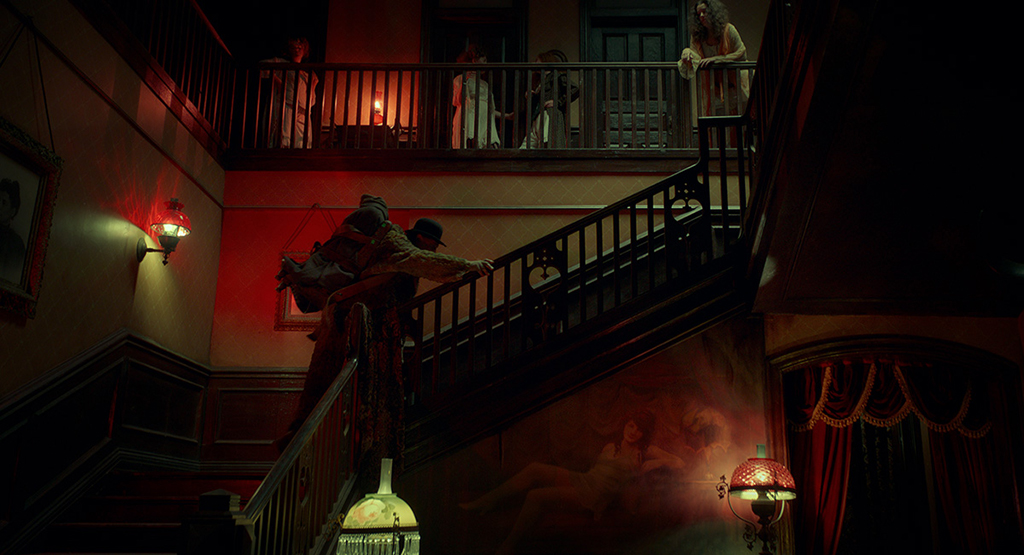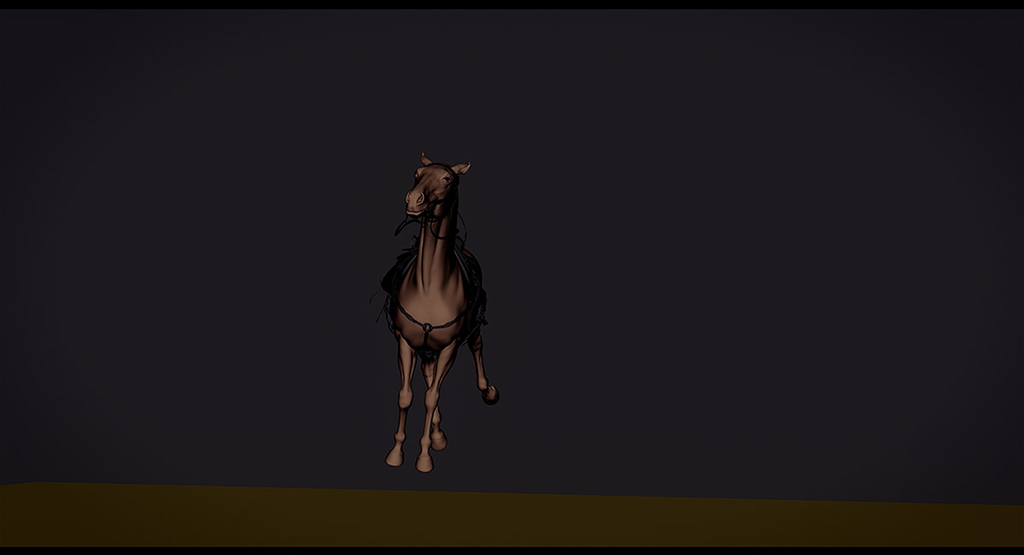By IAN FAILES

By IAN FAILES

The Coen brothers’ The Ballad of Buster Scruggs is a western with a difference – it’s actually six vignettes, all of which take place in the American frontier. Most audience members experienced the film via Netflix rather than at cinemas.
It’s also a film that features significant, yet invisible visual effects work. This was overseen by Visual Effects Supervisors Alex Lemke and Michael Huber of east side effects. They worked with several vendors around the world to deliver environment effects, blood and gore, digital animals, and even a legless, armless man.
In this special VFX Voice breakdown, Lemke and Huber detail how visual effects helped make the film possible.
We were first approached about The Ballad of Buster Scruggs in January 2017. We went through the script with Joel and Ethan Coen and designed what we call a ‘VFX Bible,’ which outlined how we think certain effects could be achieved. After that, we started collecting references from other films or real-life footage. The whole project, like any other film of theirs, was storyboarded by J. Todd Anderson, who has been their go-to storyboard guy since Raising Arizona. These storyboards gave a pretty good indication of what to expect, but there were still a lot of changes due to the nature of the project, such as weather, shooting with animals, and more.
They were also interested in keeping the VFX close to their editorial, and have us be in charge of dealing with external vendors where it was necessary. So we assembled an extensive in-house team under our east side effects banner and worked as the hub for the external work coming in from vendors in New York and around the globe.
We talked early on about the levels of gore Joel and Ethan wanted to see here – not so much Tarantino, but more Peckinpah with a dash of Looney Tunes. For the fingers being shot off, we painted out the actor’s fingers and added little stumps of bone. Michael Huber – together with Martin Grassl from BigHugFX – developed a digital asset in Houdini for blood simulations, which we could then re-use and tweak on a per shot basis, adjusting volume, velocity, direction and impact. Additionally, we used blood-spatter elements and wound elements to enhance the practical make-up. Originally, we went a bit over the top: for example, the thumb wasn’t fully shot off, but still attached to the actor’s hand and dangling back and forth hilariously. But the brothers had a very good idea of how far they really wanted to take the violence.



“We were first approached about The Ballad of Buster Scruggs in January 2017. We went through the script with Joel and Ethan Coen and designed what we call a ‘VFX Bible,’ which outlined how we think certain effects could be achieved.”
—Alex Lemke and Michael Huber, Visual Effects Supervisors, east side effects
Plates of actor Tim Blake Nelson were shot by the main unit outdoors against bluescreen, with him either hanging from wires, courtesy of SFX Supervisor Steve Cremin, or by placing him on a moving slant board. Backgrounds were either plates or a mixture of cloud photography and 2.5D matte painting elements. The wings, created by BigHugFX, went through a number of iterations for size and shape. We finally settled on a ‘swan-like’ shape in a medium size. The animation was timed to match the three-quarter beat of the song. BigHug added little touches in the animation, like the stretching out of the wings at the beginning, as if they are waking up. The Lyre was added as a CGI element, which we seamlessly transitioned into the real one from set. CG dust and smoke elements helped with the ghost transition.
The ‘wingless thrush’ – as he is referred to on a poster in the film – was a combined effort of the art department, special effects, costume design, VFX and, of course, Harry Melling’s incredible stamina. He was performing this poetry while standing in a hole in the ground with his hands behind his back, and went for it take after take, sometimes in the freezing cold. It was clear that 98% of all shots would be painting out his arms and legs, so SFX Supervisor Steve Cremin had to devise a way to cut holes into the set and his chair to make it appear he was resting on his stumps.



“[The Coen brothers] were also interested in keeping the VFX close to their editorial, and have us be in charge of dealing with external vendors where it was necessary. So we assembled an extensive in-house team under our east side effects banner and worked as the hub for the external work coming in from vendors in New York and around the globe.”
—Alex Lemke and Michael Huber, Visual Effects Supervisors, east side effects
Our costume designer, Mary Zophres, had the great idea of having him wear a regular shirt where the long sleeves were just folded up, which helped with hiding his arms. He wasn’t wearing any blue garment, just black – which helped with not getting any unnecessary color spill in the set. Alex was on set to make sure we would shoot clean plates after each setup. Luckily, the Coen brothers’ approach to these shots really focused on Harry’s performance in long locked-off takes, so we didn’t have to deal with a lot of camera motion. We also helped Harry’s look by warping his shoulders closer to his body in some shots.
In the most ambitious shots, the actor is carried up a flight of stairs in a chair/backpack and put on the ground. These shots were quite complicated head replacements, where we object-tracked the backpack and re-engineered the moves onto a motion-control/motion base setup to get the correct motions for the head. A lot of 2D work was still needed to match up the elements and add subtle breathing motion to the dummy used on set.
Most of the location is actually real. This was shot in a valley an hour away from Telluride in Colorado. Production designer Jess Gonchor really found something fantastic there. We added a mountain range in the background in some angles to make the valley seem even more isolated and removed every hint of civilization to make it feel remote and untouched by humans. Since production was on a tight schedule and weather was a big issue, we shot sometimes out of sequence, so a lot of fixes also included continuity issues.



“Most of the location [in ‘All Gold Canyon’] is actually real. This was shot in a valley an hour away from Telluride in Colorado. Production designer Jess Gonchor really found something fantastic there. We added a mountain range in the background in some angles to make the valley seem even more isolated and removed every hint of civilization to make it feel remote and untouched by humans.”
—Alex Lemke and Michael Huber, Visual Effects Supervisors, east side effects
For the deer in ‘All Gold Canyon,’ the plan for a long time was to shoot a real deer against bluescreen, but it became clear that we might not get the very specific actions Joel and Ethan wanted to see. They were referencing the opening of the classic western Shane, which has this great shot of the titular character appearing through the antlers of a deer. It became clear it would have to be a digital solution, and we were very happy to get the Mill in New York to work on that for us. Eventually, they would also handle all the other critters in the opening sequence.
The most challenging shots in ‘The Gal Who Got Rattled’ were two fully digital horse falls that Iloura (now Method Studios) in Sydney did for us. Joel and Ethan wanted these to feel really violent, with the horse stepping into prairie dog holes and then tumbling forward – something you couldn’t achieve practically. For the shot of the chief’s horse falling, we used a plate of a stuntman falling off a real horse, which was then painted out and replaced with an animated one.



“We talked early on about the levels of gore Joel and Ethan wanted to see here – not so much Tarantino, but more Peckinpah with a dash of Looney Tunes.”
—Alex Lemke and Michael Huber, Visual Effects Supervisors, east side effects
The idea for ‘The Mortal Remains’ was to be almost a stage play set inside a carriage – the landscape outside was supposed to be very nondescript and abstract. Joel and Ethan referenced the train sequence in Il Conformista for the look of it. DP Bruno Delbonnel shot the sequence with animated lighting on stage, going from sunset to a night mood against bluescreen. The abstract landscape was then created by Phosphene and composited by Crafty Apes.
For the shot of the Frenchmen leaning out the window, we created the exterior in Nuke using projected photographs and added CG assets like a windblown scarf and the coachman’s whip. Iloura again did the horses for us, including harnesses and reins, and we combined it all together. For the final shot of the carriage speeding off, we shot a plate of the real carriage being pulled by an electrical car on stage, then painted it out, extended the set and added Iloura’s CG horses.

